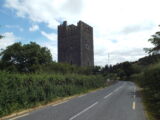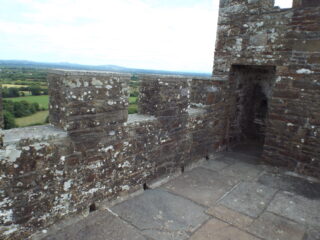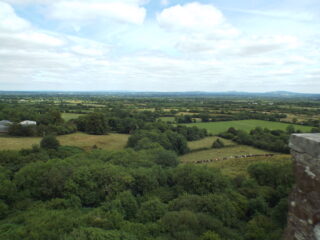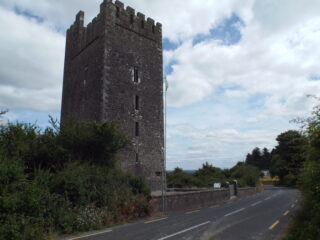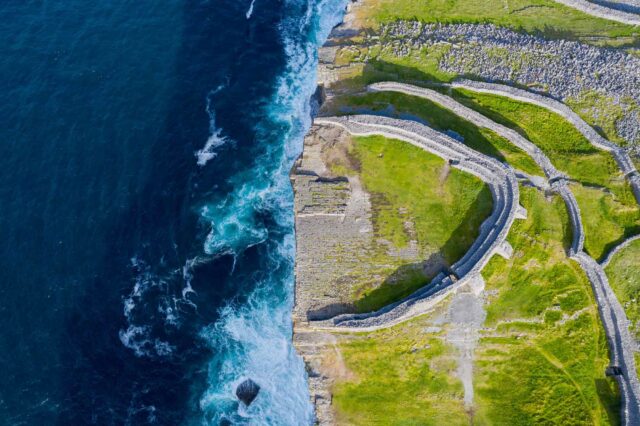Fógra
WARNING: It should be noted that these sites are unguided and a level of care and caution should be maintained during all stages of your visit. The Office Of Public Works (OPW) will not be held responsible for any damages, injuries, or losses that occur
Glenquin Castle
Glenquin Castle is a tower-house in Killeady, about 9km south of the town of Newcastle West. The tower-house was built by the O’Hallinan Family sometime in the late 15th or early 16th century. According to local tradition it was built on the site of an earlier fortification constructed by the O’Brien’s in the 10th century.
The place name, Glenquin, comes from the Irish name Gleann an Choim (The Sheltered Glen). The castle was originally a typical tower-house with three floors. The ground floor would have been a kitchen, food storage area, and possibly service quarters. The first floor had a banqueting hall with barrel vaulted ceiling, whilst the top floor would have been the living quarters for the O’Hallinan Family. The upper two levels were later subdivided with new wooden floors installed on both levels, converting the tower house into a five storey building, and new windows were added. The corbel stones that supported these two floors can still be seen on the upper levels. There is a murder hole on the first floor immediately above the entrance door. If an enemy succeeded in entering the castle during an attack this would have been used to pour boiling water down on any attacker, or alternatively to drop large rocks or shoot arrows at intruders. The north gable on the top floor also features two archer’s perches to protect bowmen during battle.
Glenquin Castle was briefly taken from the O’Hallinans by the O’Briens before it came into the possession of the Fitzgerald Earls of Desmond. When the Fitzgeralds rebelled against the English Crown during the First Desmond Rebellion of 1569 -1573 Glenquin Castle was captured by the English and granted to Sir Walter Ralleigh in 1571. Ralleigh is said to have demolished part of the castle, presumably to prevent it being used by the rebels. After the Second Desmond Rebellion of 1579 -1583 the castle was granted to Sir William Courtney, the Member of Parliament and Sheriff of Devon who gained control of the Fitzgerald’s former estate at Newcastle West.
According to local tradition the castle was last occupied in the late 17th Century. In the early 19th Century Alfred Furlong, the land agent for William Courtney the 10th Earl of Devon, carried out extensive restoration works on the castle, which was later followed by further conservation works by the Office of Public Works.
During the 1916 Rising Glenquin Castle, which was then vacant, served as the rallying point for the local members of the Irish Volunteers who mustered there in anticipation of a shipment of arms from Germany. When the arms shipment failed to arrive the poorly armed rebels dispersed without taking offensive action against the British forces. In 1966 a plaque was unveiled near the castle to commemorate the 50th anniversary of the 1916 Rising.
Protect our Past - Click here to read about the importance of protecting our country’s unique heritage sites
This national monument is protected in accordance with the National Monuments Acts 1930 to 2014
Gailearaí
Suíomhanna cóngarach
Caisleán Dheasumhan – An Caisleán Nua Thiar
Áit a ndéanann fuaimeanna ragairne na meánaoise macalla timpeall na mballaí
Timpeall 8.1 km ón
Caisleán Eas Géitine
Fothrach a bhíodh ina dhaingean ag Iarlaí Dheasumhan
Timpeall 25.7 km ón
Caisleán Lios Tuathail
Urdhún deireanach na Mhuireasach
Timpeall 26.6 km ón
Caisleán Áth Dara
Sárshaothar meánaoiseach, a tógadh mar chosaint
Timpeall 29.4 km ón
Inis Cathaigh agus an tIonad Cuairteoirí
Faigh amach faoi Stair, Miotas agus Finscéal Inis Cathaigh
Timpeall 37.7 km ón
Cúirt agus Eastát Dhún ar Aill
Leagan fíorshaoil de Downton Abbey i dTuaisceart Chorcaí
Timpeall 40.2 km ón
